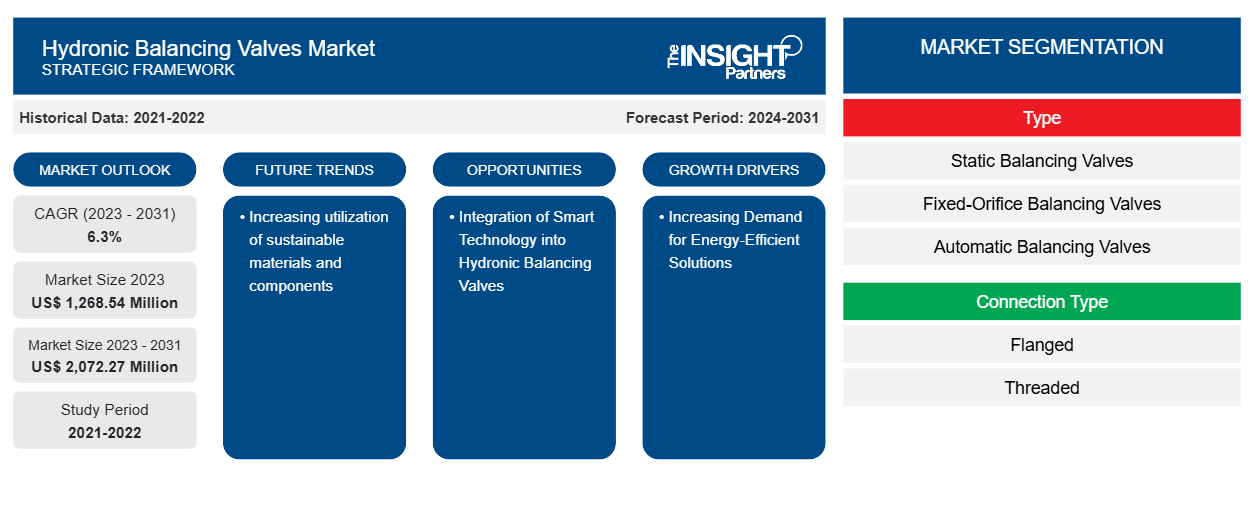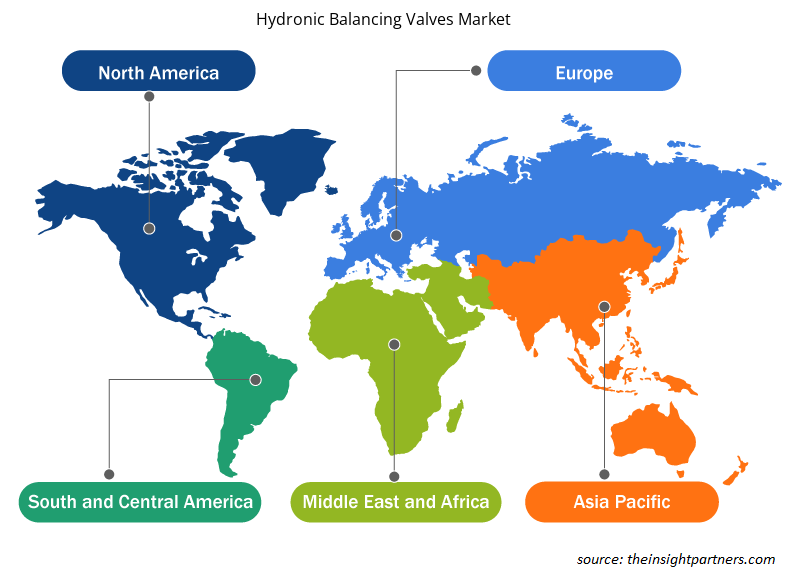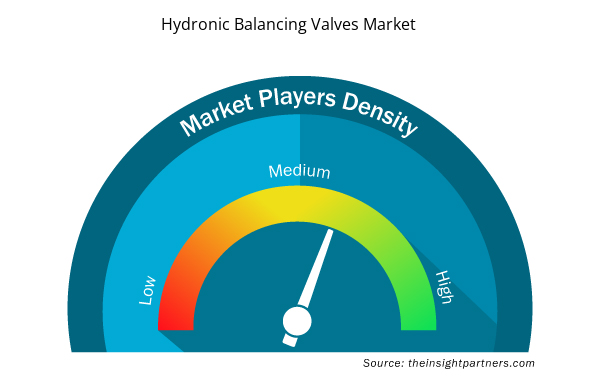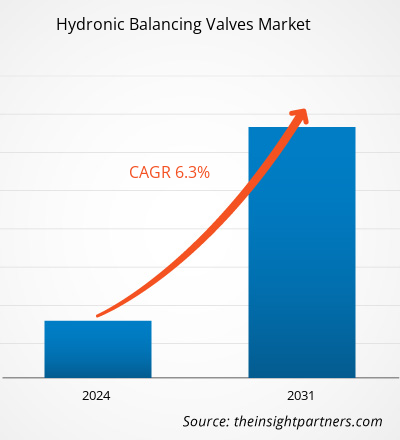The hydronic balancing valves market size is projected to reach US$ 2,072.27 million by 2031 from US$ 1,268.54 million in 2023. The market is expected to register a CAGR of 6.3% during 2023–2031. Increasing utilization of sustainable materials and components in infrastructure construction is likely to remain a key trend in the market.
Hydronic Balancing Valves Market Analysis
The population is rapidly increasing in developed economies such as the US, which contributes to the growth in the number of commercial spaces. According to the updated list of urban areas provided by the United States Census Bureau in December 2022, the urban population in the US increased by ~6.4% between 2010 and 2020. Urban areas have become denser because of urbanization, with an average population density rise from ~2,343 in 2010 to ~2,553 in 2020. As per the 2020 Census data, the western region of the US is the most urban, with ~88.9% of its population inhabiting an urban area, followed by the northeast region with ~84.0%. The Midwest and South regions exhibit a lower percentage of the population residing in urban sections, with rates of ~75.8% and ~74.3%, respectively. Further, the urban standard of living requires proper, well-maintained residential and commercial building infrastructure, which drives the demand for HVAC systems. Thus, the rising urbanization across the globe propels the application of hydronic balancing valves, which fuels the market growth.
Hydronic Balancing Valves Market Overview
Balancing valves are throttling devices used to regulate the flow of fluid through hydronic systems. In hydronic heating, ventilation, and air conditioning (HVAC) systems, balancing valves facilitate the distribution of heated or cooled water to all terminals, considering the current system conditions. Hydronic balancing valves ensure optimal performance, high operating efficiency, and lower operating costs for hydronic heating and cooling systems. The fluid flow in an HVAC system constantly changes to adapt to varying conditions in the system. Factors that influence heating and cooling needs include building occupancy and solar heat. Properly designed and constructed HVAC systems are required to deliver the right power when and where it is needed.
A rise in demand for hydronic balancing valves from hydronic system applications such as radiators, HVAC systems, heat exchangers, power generation systems, server cooling systems, and radiant heating systems drives the hydronic balancing valves market. In addition, increasing energy efficiency regulations across the globe to minimize carbon emissions fuels the demand for hydronic balancing valves. Moreover, the upsurge in construction activities in residential and commercial sectors has resulted in rising demand for HVAC systems, which, in turn, is projected to propel the hydronic balancing valves market growth from 2023 to 2031.
Customize This Report To Suit Your Requirement
You will get customization on any report - free of charge - including parts of this report, or country-level analysis, Excel Data pack, as well as avail great offers and discounts for start-ups & universities
Hydronic Balancing Valves Market: Strategic Insights

- Get Top Key Market Trends of this report.This FREE sample will include data analysis, ranging from market trends to estimates and forecasts.
Customize This Report To Suit Your Requirement
You will get customization on any report - free of charge - including parts of this report, or country-level analysis, Excel Data pack, as well as avail great offers and discounts for start-ups & universities
Hydronic Balancing Valves Market: Strategic Insights

- Get Top Key Market Trends of this report.This FREE sample will include data analysis, ranging from market trends to estimates and forecasts.
Hydronic Balancing Valves Market Drivers and Opportunities
Increasing Demand for Energy-Efficient Solutions
Consumer preference for energy-efficient appliances has been growing in recent times. Energy efficiency can provide long-term benefits by reducing overall electricity demand by lowering the need to invest in new infrastructure for electricity generation and transmission. It also contributes to the diversification of utility resource portfolios and can act as a buffer against the risk of volatile energy procurement expenditure. To attain energy efficiency, many manufacturing industries and commercial manufacturing companies are procuring high-efficiency HVAC systems. An efficient HVAC system utilizes less energy and operates more effectively than conventional systems, lowering the carbon footprint. In hydronic systems, the balancing valves facilitate the distribution of chilled or heated water to all terminals. The growing application of HVAC (Heating, Ventilation, and Air Conditioning) systems in air conditioning and heat pumps for achieving energy and the growing implementation of energy efficiency standards for public buildings are boosting the demand for HVAC systems in various industrial and commercial sectors.
Integration of Smart Technology into Hydronic Balancing Valves
The penetration of IoT-enabled devices across residential, commercial, and industrial sectors is increasing worldwide. As a result, hydronic balancing valve manufacturers are providing their customers with unique solutions and developing smart hydronic balancing valves that can be integrated into smart HVAC systems. Smart hydronic balancing valves utilize the features of the Internet, such as real-time monitoring, data analysis capabilities, and automated balancing. By connecting these valves to Building Management Systems (BMS), remote monitoring can be achieved, which significantly enhances energy efficiency and system performance. Smart HVAC systems leverage wireless technology to communicate with nearby smart devices and adjust the indoor environment automatically. In commercial settings, smart HVAC systems can aid in energy saving while providing a quieter environment.
Hydronic Balancing Valves Market Report Segmentation Analysis
Key segments that contributed to the derivation of the hydronic balancing valves market analysis are type, connection type, size, and application.
- Based on type, the hydronic balancing valves market is segmented into static balancing valves, fixed orifice balancing valves, automatic balancing valves, and pressure-independent flow control valves. The static balancing valves segment held the larger market share in 2023.
- By size, the market is segmented into less than 5”, 6”–10”, 11”–20”, and above 20”. The less than 5” segment dominated the market in 2023.
- Based on connection type, the market is segmented into Flanged, Threaded, and Others. Flanged segment dominated the market in 2023
- By application, the market is segmented into residential, commercial, and industrial. Residential segment held the larger market share in 2023.
Hydronic Balancing Valves Market Share Analysis by Geography
The geographic scope of the hydronic balancing valves market report is mainly divided into five regions: North America, Asia Pacific, Europe, Middle East & Africa, and South & Central America.
Asia Pacific dominated the hydronic balancing valves market in 2023. The Asia Pacific hydronic balancing valves market is segmented into China, India, Japan, Australia, South Korea, and the Rest of Asia Pacific. The market growth in Asia Pacific is largely attributed to increasing urbanization, along with rising population growth, which is driving the need for smart infrastructure. Additionally, government regulations focused on encouraging the application of energy-efficient heating and cooling solutions are boosting the demand for hydronic balancing valves in Asia Pacific. The region is witnessing growth in several real estate projects and public-private investments in numerous industrial, residential, and commercial development areas due to the rapid rise in urbanization. The need for HVAC services in the residential sector is primarily driven by new installations across the region. Due to increased building and development projects, the installation of air conditioners is rising across Southeast Asia nations, including Vietnam, Malaysia, Thailand, Indonesia, the Philippines, and China, which is anticipated to propel the hydronic balancing valves market in Asia Pacific during the forecast period.
Hydronic Balancing Valves Market Regional Insights
The regional trends and factors influencing the Hydronic Balancing Valves Market throughout the forecast period have been thoroughly explained by the analysts at Insight Partners. This section also discusses Hydronic Balancing Valves Market segments and geography across North America, Europe, Asia Pacific, Middle East and Africa, and South and Central America.

- Get the Regional Specific Data for Hydronic Balancing Valves Market
Hydronic Balancing Valves Market Report Scope
| Report Attribute | Details |
|---|---|
| Market size in 2023 | US$ 1,268.54 Million |
| Market Size by 2031 | US$ 2,072.27 Million |
| Global CAGR (2023 - 2031) | 6.3% |
| Historical Data | 2021-2022 |
| Forecast period | 2024-2031 |
| Segments Covered |
By Type
|
| Regions and Countries Covered | North America
|
| Market leaders and key company profiles |
Hydronic Balancing Valves Market Players Density: Understanding Its Impact on Business Dynamics
The Hydronic Balancing Valves Market market is growing rapidly, driven by increasing end-user demand due to factors such as evolving consumer preferences, technological advancements, and greater awareness of the product's benefits. As demand rises, businesses are expanding their offerings, innovating to meet consumer needs, and capitalizing on emerging trends, which further fuels market growth.
Market players density refers to the distribution of firms or companies operating within a particular market or industry. It indicates how many competitors (market players) are present in a given market space relative to its size or total market value.
Major Companies operating in the Hydronic Balancing Valves Market are:
- Danfoss AG
- Hays Fluid Controls
- Victaulic Company
- Red-White Valve Corp.
- Oventrop Corporation
- Caleffi SpA Siemens
Disclaimer: The companies listed above are not ranked in any particular order.

- Get the Hydronic Balancing Valves Market top key players overview
Hydronic Balancing Valves Market News and Recent Developments
The hydronic balancing valves market is evaluated by gathering qualitative and quantitative data post primary and secondary research, which includes important corporate publications, association data, and databases. A few of the developments in the market for hydronic balancing valves are listed below:
- The CALEFFI Group announced the completion acquisition of the Fratelli Creola S.r.l. This company has been operating in the local galvanic industry for more than 60 years, specializing in chrome and nickel plating. The two companies hold a long-standing partnership based on mutual esteem, which started with the founders Francesco Caleffi and Lorenzo and Quinto Creola and continues with Marco Caleffi and Marco Creola. (Source: CALEFFI Group, Press Release July, 2023)
- Mantro; Oventrop GmbH & Co. KG, the Sauerland-based family business; and the Düsseldorf-based LEG Immobilien SE have founded the joint venture seero, which develops green solutions featuring heating and sustainability for residential properties. seero.Pro is the first digital solution which was announced by the cross-industry trio at the ISH in March. Seero.Pro automatically carries out the hydronic balancing of the heating system for each radiator. Additional heating costs are saved on the basis of intelligent, smart heating through demand-led temperature control. (Source: Oventrop GmbH & Co. KG, Press Release, April 2023)
Hydronic Balancing Valves Market Report Coverage and Deliverables
The “Hydronic Balancing Valves Market” Size and Forecast (2021–2031)” report provides a detailed analysis of the market covering below areas:
- Hydronic balancing valves market size and forecast at global, regional, and country levels for all the key market segments covered under the scope
- Hydronic balancing valves market trends as well as market dynamics such as drivers, restraints, and key opportunities
- Detailed PEST/Porter’s Five Forces and SWOT analysis
- Hydronic balancing valves market analysis covering key market trends, global and regional framework, major players, regulations, and recent market developments
- Industry landscape and competition analysis covering market concentration, heat map analysis, prominent players, and recent developments for the hydronic balancing valves market
- Detailed company profiles
- Historical Analysis (2 Years), Base Year, Forecast (7 Years) with CAGR
- PEST and SWOT Analysis
- Market Size Value / Volume - Global, Regional, Country
- Industry and Competitive Landscape
- Excel Dataset


- Pharmacovigilance and Drug Safety Software Market
- Occupational Health Market
- Online Recruitment Market
- Automotive Fabric Market
- Unit Heater Market
- Parking Management Market
- Small Molecule Drug Discovery Market
- Blood Collection Devices Market
- Electronic Signature Software Market
- Smart Grid Sensors Market

Report Coverage
Revenue forecast, Company Analysis, Industry landscape, Growth factors, and Trends

Segment Covered
This text is related
to segments covered.

Regional Scope
North America, Europe, Asia Pacific, Middle East & Africa, South & Central America

Country Scope
This text is related
to country scope.
Frequently Asked Questions
The penetration of IoT-enabled devices across residential, commercial, and industrial sectors is increasing worldwide. As a result, hydronic balancing valve manufacturers are providing their customers with unique solutions and developing smart hydronic balancing valves that can be integrated into smart HVAC systems.
Regions such as Asia-Pacific, Europe and North America will boost the growth of the hydronic balancing valves market during the forecast period. This growth is owing to the rise in urbanization and industrialization in the regions.
Consumer preference for energy-efficient appliances has been growing in recent times. Energy efficiency can provide long-term benefits by reducing overall electricity demand by lowering the need to invest in new infrastructure for electricity generation and transmission. It also contributes to the diversification of utility resource portfolios and can act as a buffer against the risk of volatile energy procurement expenditure. To attain energy efficiency, many manufacturing industries and commercial manufacturing companies are procuring high-efficiency HVAC systems. An efficient HVAC system utilizes less energy and operates more effectively than conventional systems, lowering the carbon footprint. In hydronic systems, the balancing valves facilitate the distribution of chilled or heated water to all terminals.
Utilization of Sustainable Materials and Components in Public Infrastructure the hydronic balancing valves market growth in the coming years.
Danfoss AG; Hays Fluid Controls; Victaulic Company; Red-White Valve Corp.; Oventrop Corporation; Caleffi SpA Siemens; Frese Group; Johnson Controls, Inc.; American Wheatly; and Xylem are the key market players operating in the global hydronic balancing valves market.
Trends and growth analysis reports related to Manufacturing and Construction : READ MORE..
The List of Companies - Hydronic Balancing Valves Market
- Danfoss AG
- Hays Fluid Controls
- Victaulic Company
- Red-White Valve Corp.
- Oventrop Corporation
- Caleffi SpA Siemens
- Frese Group
- Johnson Controls, Inc.
- American Wheatly
- Xylem

 Get Free Sample For
Get Free Sample For